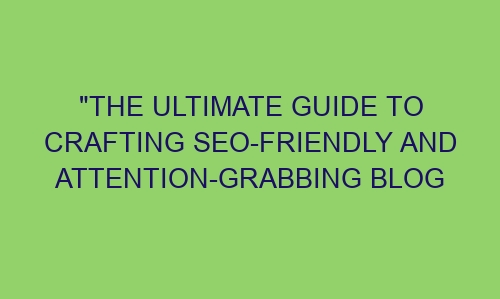Introduction
Have you ever written a blog post that you were really proud of, only to find out that it didn’t get the attention it deserved? The truth is, great content alone isn’t enough. You also need a compelling title that grabs readers’ attention and entices them to click through and read your post. But how do you write a title that both appeals to humans and search engines? This ultimate guide will provide you with the tools and techniques you need to craft SEO-friendly and attention-grabbing blog post titles.
1. Keep it short and sweet
When it comes to blog post titles, less is often more. A title that’s too long can be confusing and hard to read, and may not be fully displayed in search results. Aim for a title that’s 60-70 characters long, including spaces, to ensure that it’s both clear and visible. Additionally, using short and punchy words in your title can grab readers’ attention and convey a sense of urgency.
2. Use numbers and lists
People love lists, and incorporating them into your blog post title can make it more enticing. Using numbers, such as “5 tips for…” or “10 ways to…”, adds structure to your post and gives readers a clear idea of what to expect. Lists also provide a quick and easy-to-read overview of your post’s content, which can be particularly helpful for busy readers.
3. Be specific and descriptive
A vague or generic blog post title is unlikely to pique readers’ interest or help your post rank well in search results. Instead, be specific and descriptive about what your post offers and what readers can expect to learn. For example, “The ultimate guide to crafting SEO-friendly and attention-grabbing blog post titles” is more descriptive than “How to improve your blog post titles.”
4. Keyword research is key
Before you start crafting your blog post title, it’s important to do some keyword research to ensure that you’re targeting the right audience. Identify long tail keywords that are relevant to your post’s topic and incorporate them into your title. This will not only make your title more SEO-friendly, but also help it stand out in a crowded blogosphere.
5. Use power words
Power words are emotionally-charged words that are proven to grab readers’ attention and elicit a response. Incorporate power words into your blog post title to make it more compelling and memorable. Some examples of power words include “ultimate,” “proven,” “surprising,” and “jaw-dropping.”
6. Arouse curiosity
Creating anticipation and curiosity in your blog post title can be an effective way to entice readers to click through and read your post. Using phrases such as “you won’t believe” or “the surprising truth about” can spark readers’ interest and encourage them to learn more.
7. A/B test your titles
Sometimes, the only way to know which blog post title will perform best is to test it. Consider writing multiple titles for your post and using A/B testing to determine which one is the most effective. This can involve sharing the post on social media with different titles or using a tool such as Google Optimize to test two different titles against each other.
FAQs
1. What is a long tail keyword?
A long tail keyword is a specific, niche keyword phrase that contains at least three words. They are often used in SEO to target a specific audience and rank higher in search results.
2. How do I research long tail keywords?
There are a variety of tools available for researching long tail keywords, including Google Keyword Planner, SEMrush, and Ahrefs.
3. How many keywords should I include in my blog post title?
Ideally, you should aim to include one primary keyword and one or two secondary keywords in your blog post title.
4. Can I use clickbait in my blog post title?
While clickbait titles may grab readers’ attention in the short term, they can also lead to frustration and distrust in the long term. Aim to be truthful and transparent in your blog post titles.
5. Should I include my brand name in my blog post title?
Unless your brand name is already well-known and recognized by your target audience, it’s generally not necessary to include it in your blog post title.
6. Is it better to use sentence case or title case in my blog post title?
While both options are acceptable, using title case (capitalizing the first letter of each word except for articles, conjunctions, and prepositions) can give your title a more polished and professional look.
7. Can I update my blog post title after it’s published?
Yes, you can update your blog post title after it’s published. This can be particularly useful if you find that your initial title isn’t performing as well as you’d hoped.
Conclusion
Crafting an SEO-friendly and attention-grabbing blog post title is an essential part of blogging. By keeping your title short and sweet, using numbers and lists, being specific and descriptive, conducting keyword research, using power words, arousing curiosity, and A/B testing your titles, you can create titles that resonate with both humans and search engines. Remember to be transparent and truthful in your titles, and don’t be afraid to experiment to find what works best for your audience. Above all, have fun and be creative – after all, your title is often the first impression readers will have of your post!

